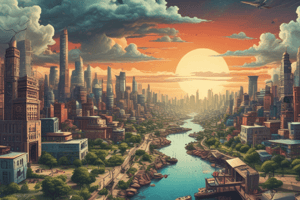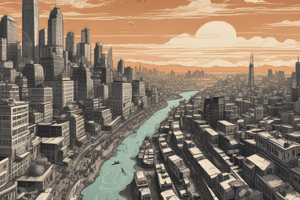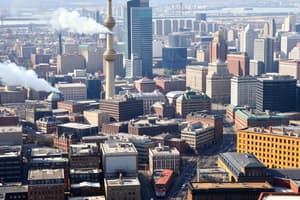Podcast
Questions and Answers
Only one room in each of the apartments was directly exposed to ______ and open air.
Only one room in each of the apartments was directly exposed to ______ and open air.
sunlight
Families on a floor shared the toilet in the ______.
Families on a floor shared the toilet in the ______.
hallway
In 1871, two-thirds of downtown Chicago burned in a raging ______.
In 1871, two-thirds of downtown Chicago burned in a raging ______.
fire
Toilets are at the center of the hallway, while fire escapes are at each ______.
Toilets are at the center of the hallway, while fire escapes are at each ______.
The wealthiest began to leave the risky cities behind and head for semirural ______.
The wealthiest began to leave the risky cities behind and head for semirural ______.
In 1860, no city in the United States could boast a million ________.
In 1860, no city in the United States could boast a million ________.
By 1900, New York, with some 3.5 million people, was the second-largest city in the ________.
By 1900, New York, with some 3.5 million people, was the second-largest city in the ________.
The skyscraper, supported by its skeleton of steel, was made viable thanks to the electric ________.
The skyscraper, supported by its skeleton of steel, was made viable thanks to the electric ________.
Louis Sullivan contributed to the development of skyscrapers with his principle that 'form follows ________.'
Louis Sullivan contributed to the development of skyscrapers with his principle that 'form follows ________.'
Electric trolleys propelled city limits explosively ________.
Electric trolleys propelled city limits explosively ________.
The first subway in the nation opened in ________ at the end of the century.
The first subway in the nation opened in ________ at the end of the century.
By the late 19th century, the compact 'walking city' gave way to the immense and impersonal ________.
By the late 19th century, the compact 'walking city' gave way to the immense and impersonal ________.
Industrial jobs primarily drew people off American and European ________ and into factory centers.
Industrial jobs primarily drew people off American and European ________ and into factory centers.
Electricity, indoor plumbing, and ______ made life in the big city more enticing.
Electricity, indoor plumbing, and ______ made life in the big city more enticing.
The Brooklyn Bridge opened on ______ 24, 1883.
The Brooklyn Bridge opened on ______ 24, 1883.
On opening day, 1800 vehicles and ______ people crossed the Brooklyn Bridge.
On opening day, 1800 vehicles and ______ people crossed the Brooklyn Bridge.
Emily Warren Roebling was the first person to ______ the Brooklyn Bridge.
Emily Warren Roebling was the first person to ______ the Brooklyn Bridge.
Cavernous department stores like Macy's in New York attracted ______ shoppers.
Cavernous department stores like Macy's in New York attracted ______ shoppers.
Before moving to the city, Carrie Meeber lived in the ______.
Before moving to the city, Carrie Meeber lived in the ______.
In the city, goods came in throwaway ______, boxes, bags, and cans.
In the city, goods came in throwaway ______, boxes, bags, and cans.
The streets of cities were often enveloped in a satanic ______.
The streets of cities were often enveloped in a satanic ______.
Baltimore was described as smelling like a billion ______.
Baltimore was described as smelling like a billion ______.
Worst of all were the human pigsties known as ______.
Worst of all were the human pigsties known as ______.
The 'dumbbell' tenement became a standard architectural plan for housing in ______.
The 'dumbbell' tenement became a standard architectural plan for housing in ______.
Several families were sardined onto each floor of the ______-like structures.
Several families were sardined onto each floor of the ______-like structures.
In slums, many unfortunate urbanites coughed away their ______.
In slums, many unfortunate urbanites coughed away their ______.
The jagged skyline of America’s perpendicular civilization could not fully conceal the ______ sores of feverish growth.
The jagged skyline of America’s perpendicular civilization could not fully conceal the ______ sores of feverish growth.
The glaring contrasts in New York reminded one visitor of 'a lady in ball costume, with ______ in her ears, and her toes out at the boots.'
The glaring contrasts in New York reminded one visitor of 'a lady in ball costume, with ______ in her ears, and her toes out at the boots.'
Flashcards
Air shaft
Air shaft
A vertical shaft in a building that allows air and light to reach the interior.
Tenement building
Tenement building
A densely populated urban area with tall buildings and narrow streets, often characterized by limited access to sunlight and fresh air.
Fire escape
Fire escape
A fire escape is a metal structure on the exterior of a building, providing an emergency exit in case of fire.
Great Chicago Fire
Great Chicago Fire
Signup and view all the flashcards
Suburbs
Suburbs
Signup and view all the flashcards
Urban Explosion
Urban Explosion
Signup and view all the flashcards
Skyscraper
Skyscraper
Signup and view all the flashcards
Form Follows Function
Form Follows Function
Signup and view all the flashcards
Mass Transit
Mass Transit
Signup and view all the flashcards
Walking City to Megalopolis
Walking City to Megalopolis
Signup and view all the flashcards
Urban Zoning and Segregation
Urban Zoning and Segregation
Signup and view all the flashcards
Siren Song of the City
Siren Song of the City
Signup and view all the flashcards
Rural to Urban Migration
Rural to Urban Migration
Signup and view all the flashcards
The Rise of the American City
The Rise of the American City
Signup and view all the flashcards
Department Stores and Consumerism
Department Stores and Consumerism
Signup and view all the flashcards
Urban Waste and Changing Habits
Urban Waste and Changing Habits
Signup and view all the flashcards
Contradictions of Urban Growth
Contradictions of Urban Growth
Signup and view all the flashcards
Urban Slums
Urban Slums
Signup and view all the flashcards
Dumbbell Tenement
Dumbbell Tenement
Signup and view all the flashcards
Brooklyn Bridge
Brooklyn Bridge
Signup and view all the flashcards
Emily Warren Roebling
Emily Warren Roebling
Signup and view all the flashcards
Sister Carrie
Sister Carrie
Signup and view all the flashcards
Rural vs. Urban Consumption
Rural vs. Urban Consumption
Signup and view all the flashcards
Mail-Order Companies and Consumerism
Mail-Order Companies and Consumerism
Signup and view all the flashcards
Urban Disease and Sanitation
Urban Disease and Sanitation
Signup and view all the flashcards
Human Pigstys
Human Pigstys
Signup and view all the flashcards
Urban Contrasts
Urban Contrasts
Signup and view all the flashcards
Study Notes
American Metropolis Growth
- 1860: No US city had 1 million inhabitants.
- 1890: New York, Chicago, and Philadelphia surpassed 1 million inhabitants.
- 1900: New York City, with 3.5 million, was the world's 2nd largest city (after London).
- Global city growth: London, Paris, Berlin, Tokyo, Moscow, Mexico City, Calcutta, and Shanghai all doubled or tripled in size between 1850 and 1900.
- Chicago's growth: A modest town (100,000) before the Civil War, it had nearly 2 million people by 1900, a majority immigrants or children of immigrants.
Skyscrapers and Urban Expansion
- Vertical growth: Skyscrapers allowed for denser population/workspaces.
- Steel skeleton and electric elevators made skyscrapers practical: First 10-story skyscraper built in Chicago in 1885.
- Louis Sullivan's "form follows function" principle significantly impacted skyscraper design.
- Commuting: Mass transit (electric trolleys) led to explosive outward expansion of city limits.
- Boston's first subway opened by the end of the century.
- "Walking city" gave way to the vast impersonal megalopolis, divided by business, industry and residential areas, segregated by race, ethnicity, and class.
Urban Attractions
- Rural life struggled to compete with city life: Industrial jobs and city lifestyle appealed to potential newcomers.
- City amenities: Electricity, indoor plumbing, and telephones attracted people.
- Consumerism: Department stores (Macy's, Marshall Field's) attracted urban shoppers and provided jobs, sparking consumerism and highlighting class divisions.
- Engineering marvels: The Brooklyn Bridge (1883) added to the allure of cities.
Urban Challenges
- Waste disposal: Cities struggled to manage waste compared to rural areas.
- Sanitation: Population growth outpaced sanitation facilities, leading to unsanitary conditions (e.g., impure water, uncollected garbage, animal droppings).
- Baltimore's stench: Described as smelling like "a billion polecats" due to poor sanitation.
- Slums: Dense, unsanitary housing (dumbbell tenements) with poor ventilation.
- Crime: Criminals thrived in densely populated cities.
Contradictions of the City
- "Humanity compressed": City life combined the best and worst aspects of humanity.
- Contrasts: Merchant princes and paupers, elegant banks and factories, green suburbs and ghettos, skyscrapers and tenements, symbolized the sharp social inequalities faced in the cities.
- Chicago Fire of 1871: A devastating fire led to the need for stronger building materials in the urban core and influenced the departure of the wealthy to the countryside.
- Suburbs: Development of leafy bedroom communities, away from the city.
Tenements and Slums
- Dumbbell tenements (1879): Standard design on the NY Lower East Side, with inadequate ventilation and shared facilities.
- "Lung Block" (NYC): An example of crowded and unsanitary living conditions.
- "Flophouses": Cheap lodging for the homeless.
- Continuous new arrivals to slums. Despite adversity, significant upward mobility out of the worst living conditions.
Urban Hazards
- Fires: Densely packed buildings made cities vulnerable to fires (e.g., the Chicago Fire).
Studying That Suits You
Use AI to generate personalized quizzes and flashcards to suit your learning preferences.
Description
Explore the dramatic growth of American cities from 1860 to 1900. Understand how skyscrapers and advancements in mass transit transformed urban landscapes and increased population densities. This quiz covers key cities like New York, Chicago, and their global counterparts during this dynamic period.




